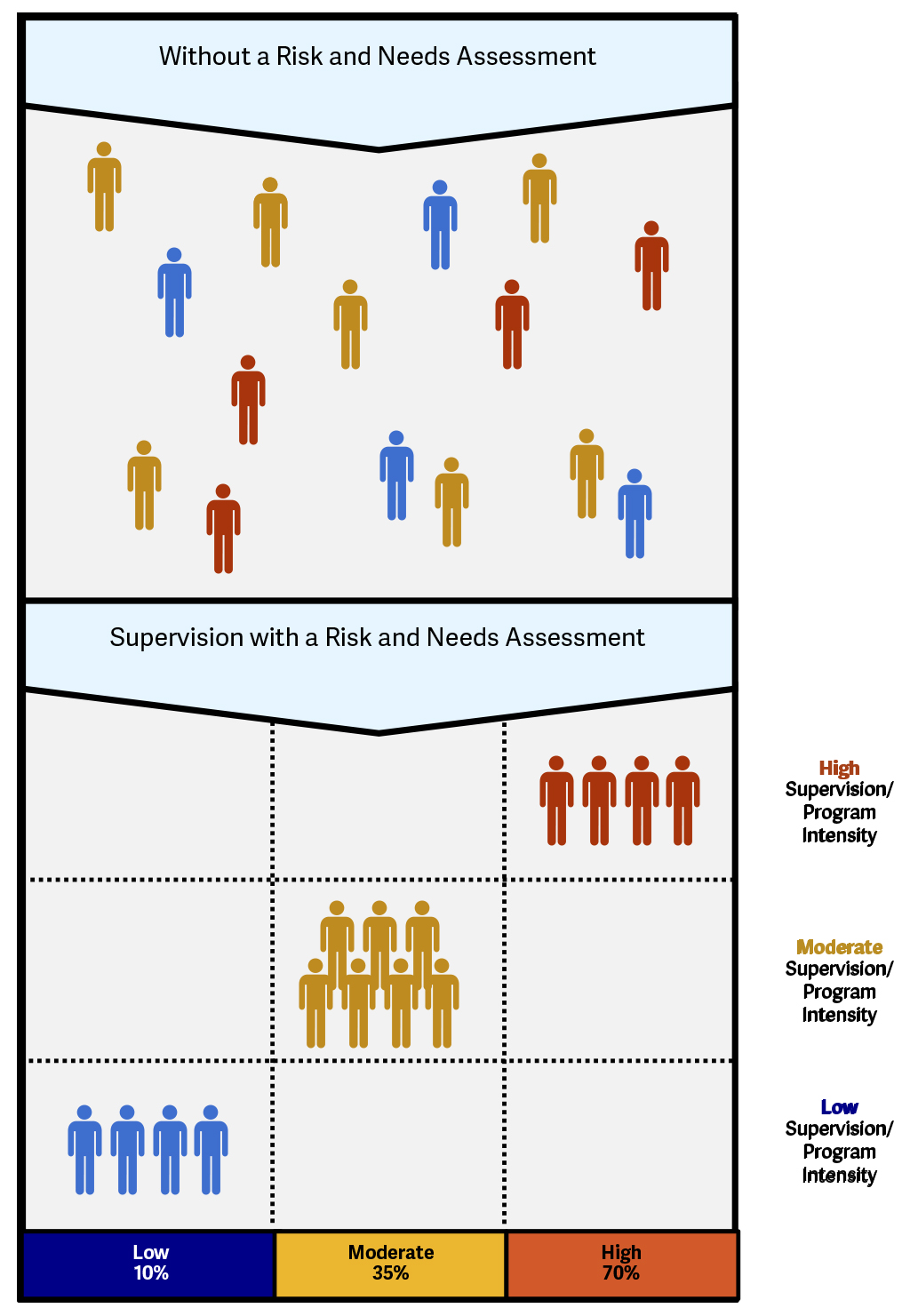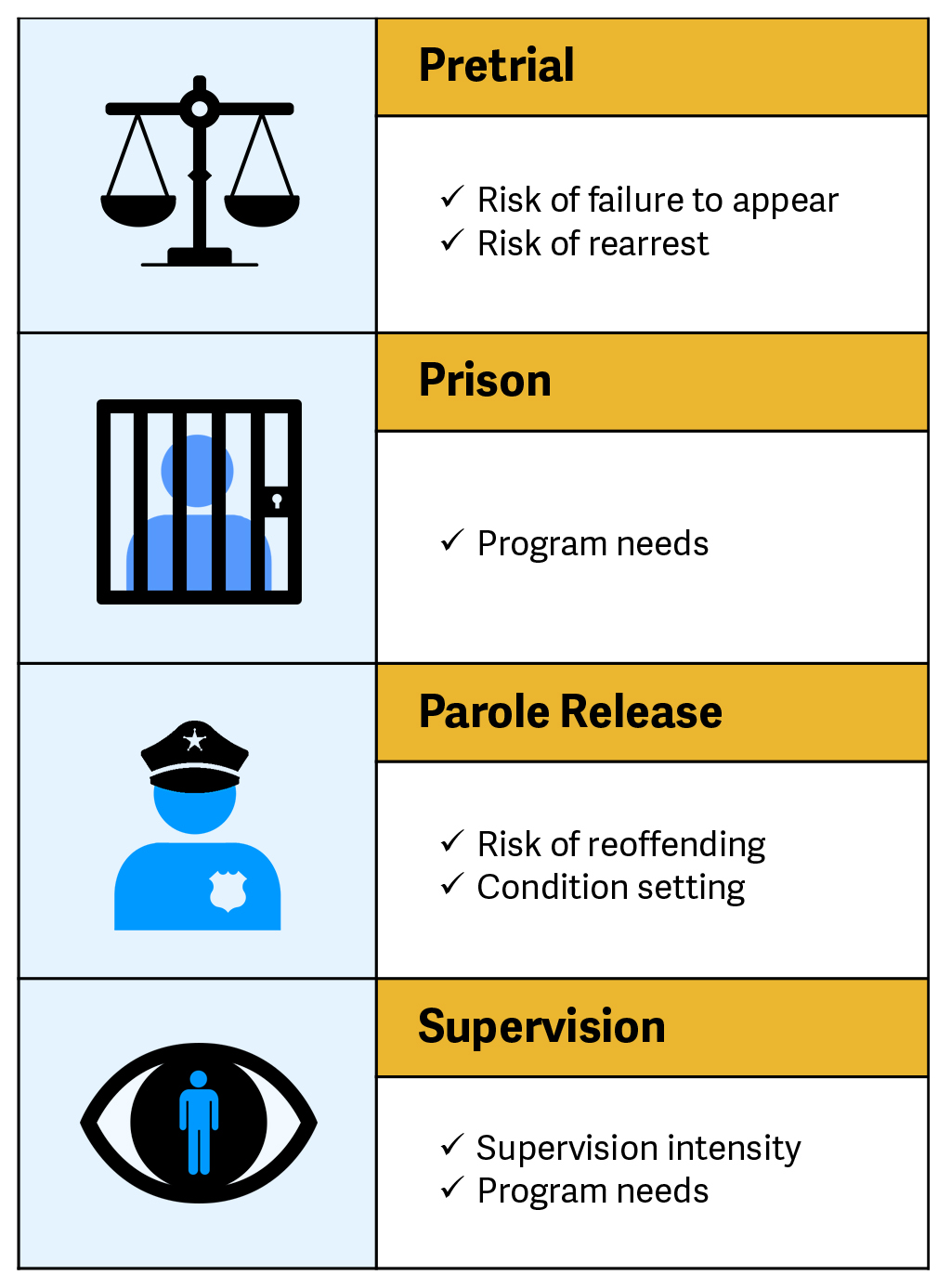Part 2, Strategy 2
Action Item 1: Design policies to support the statewide use of risk and needs assessments.
Why it matters
Criminogenic risk and needs assessments identify the presence of factors that research has shown contribute to recidivism so people can receive programs and treatment to mitigate those factors. The use of criminogenic risk and needs assessments have been shown to be more reliable than a professional’s judgment.[15] Though a criminogenic risk and needs assessment should not be the sole factor in making release, supervision, or programming decisions, it is currently the best available method for ensuring that research on what works to reduce recidivism helps inform the decision-making process.
Risk and needs assessments can and should be administered at multiple points during a person’s contact with the criminal justice system. For example, pretrial risk assessments that assess for risk of rearrest and failure to appear in court help judges make appropriate release decisions and determine whether there should be any conditions of release, such as supervision, drug testing, or electronic monitoring. (For additional information on pretrial risk assessments, see Part 1, Strategy 3) Risk and needs assessments can also inform parole release decisions. (For information on parole release decisions, see Part 3, Strategy 2).
To have a significant impact on reducing recidivism, supervision and programs must target people who have a moderate to high likelihood of reoffending. Risk and needs assessments should be used to direct supervision intensity, case planning and management, programming requirements, and treatment referrals. Supervision officers also need to reassess people at regular intervals as part of ongoing proactive monitoring to determine how they are progressing on supervision and if their risks and needs have changed. When different criminal justice agencies use different risk and needs assessments, these agencies can use a common language to increase clarity when they refer to shared populations. (For additional information on common language, see Additional Resources box below.) Further, correctional agencies can share the information collected from risk and needs assessments with other agencies, when appropriate, to streamline information collection.
What it looks like
- Require or authorize use of validated pretrial risk assessments to inform pretrial release decision making and conditions of release.
- Require supervision agencies to assess a person when placed on supervision for risk of reoffending and periodically thereafter as part of ongoing monitoring.
- See Case Study: North Carolina uses risk and needs assessments to determine supervision intensity
- Require risk and needs assessments results to be used to route people to appropriate programming focused on addressing their criminogenic needs, while incarcerated and in the community.
- See Case Study: States use risk and needs assessments to address criminogenic needs
- Require parole boards to use parole guidelines that account for factors that demonstrate a person’s readiness for parole, including risk and needs assessment results, to inform release decision making.
- Identify how corrections agencies can use information from one tool to help inform another to increase efficiency at different stages of the justice system.
- See Case Study: Ohio creates statewide risk assessment database to reduce redundancy
Key questions to guide action
- Are there statutory requirements or court rule guidance in your state that require pretrial risk assessments to be conducted to inform pretrial release?
- Are there statutory requirements or court rule guidance specifying that the results of risk and needs assessments are used to inform supervision, programming, and parole release decision making?
- How can your state ensure that the results of risk and needs assessments are interpreted consistently across agencies and across different tools?
Use the information that follows to inform your answers to these questions.
Risk and needs assessments can help corrections agencies target supervision resources to people most likely to reoffend.

Additional Resources
Criminogenic risk and needs assessment
Criminogenic risk and needs should be identified at the earliest stage of criminal justice involvement. People should be reassessed over time to monitor changes in risk level and needs. The results of criminogenic risk and needs assessments should inform comprehensive case plans to address those needs and mitigate risk of reoffending. In addition to being assessed for criminogenic risk and needs, people in the criminal justice system also need to be screened and assessed for behavioral health needs and assessed for risk of violence. To learn more about risk and needs assessment, see: In Brief: Understanding Risk and Needs Assessment.
Common language
In some states, corrections agencies use a variety of risk and needs assessments, and the same person can be assigned to different risk categories across various tools, or the same risk category can be described differently across tools. When multiple agencies use an assortment of tools, it is critical that each agency understands how the results of each risk assessment are interpreted. One step policymakers and researchers are exploring is implementing a common language related to risk assessment that ensures that corrections and other criminal justice entities have confidence that the shared terms they use can be understood across agencies as they determine the appropriate type and intensity of programming and supervision. To learn more, see: A Five-Level Risk and Needs System: Maximizing Assessment Results in Corrections through the Development of a Common Language.
Risk assessments need to be used at each stage of the justice system.

William M. Grove et al., “Clinical Versus Mechanical Prediction: A Meta-Analysis,” Psychological Assessment 12, no. 1 (2000):19–30.
Criminogenic risk and needs assessments use an actuarial evaluation to guide decision making at various points in the criminal justice continuum. These assessments approximate a person’s likelihood of reoffending and determine the individual dynamic factors that contribute to this likelihood, such as criminal thinking or attitude, that must be addressed to reduce that possibility.
Case Study
North Carolina uses risk and needs assessments to determine supervision intensity
Prior to Justice Reinvestment in North Carolina, supervision officers completed risk and needs assessments for people on probation but did not use the results to inform supervision practices. Research demonstrated that people on probation in the state who were identified as being at a high risk of reoffending were three times more likely to be rearrested within a year than people on probation who were assessed as being at a low risk.[16] Despite this, probation officers supervised everyone with the same level of intensity, regardless of their identified risk level.
To ensure that supervision officers not only assess an individual for risk of reoffending, but also use those results to inform supervision practices, North Carolina’s Justice Reinvestment Act of 2011 requires supervision officers to assess for risk of reoffending and to determine the intensity of supervision for people on probation based on risk level. Supervision officers now focus the majority of their attention on people in the highest risk group.
As the state continues to improve its supervision practices, North Carolina applied for and received a Second Chance Act grant in 2017 to use data to identify the early signs of positive and negative outcomes on supervision and develop predictive analytics to tailor supervision practices for different risk and need profiles in different geographic areas. The state aims to reduce recidivism for people who show early warning signs of struggling on supervision and maximize positive outcomes by addressing criminogenic needs.
[16] North Carolina Department of Correction, Office of Research and Planning, Verification of the Offender Traits Inventory (OTI) Scores to Likelihood of Rearrest for Probationers, (Raleigh, NC: North Carolina Department of Correction, 2009).
Case Study
States use risk and needs assessments to address criminogenic needs
To ensure that the right people are placed in the right programs, states such as Idaho and Maryland use a risk and needs assessment to direct people into programming to address their criminogenic needs while in prison and on supervision. People identified as being at a high risk of reoffending receive the most intensive programming.
Corrections agencies vary in how they identify people who have mental health and addiction treatment needs. Some agencies may screen for treatment needs when conducting a criminogenic risk assessment, while others may use specific tools aimed at screening for addiction or mental illnesses or use a combination of these tools. After agencies screen for these issues, a treatment professional will conduct a more thorough assessment on people who are identified as potentially needing treatment. For example, in addition to using a criminogenic risk and needs assessment for all people placed on probation, Nebraska probation officers use tools to screen for addiction and mental illnesses. Probation officers use the results of the screens and the risk and needs assessment to determine who should be referred to a treatment professional for further evaluation.
Case Study
Ohio creates statewide risk assessment database to reduce redundancy
Prior to the enactment of Justice Reinvestment legislation in 2011 in Ohio, the courts, probation departments, and the Ohio Department of Rehabilitation and Correction (ODRC) used different risk and needs assessments without sharing information from those assessments with each other. As a result, a person could be assessed prior to sentencing and then be sentenced to prison where they would be asked the same questions upon intake. In 2011, Ohio’s Justice Reinvestment legislation required ODRC to select a single, validated risk assessment tool for the courts, probation departments, and other criminal justice agencies to use. ODRC chose the Ohio Risk Assessment System (ORAS) and created a statewide ORAS database to house the results of the risk and needs assessments. Now, when a person enters prison, starts supervision, or enters a residential treatment center, staff use the database to access risk and needs assessments results. This streamlined approach eliminates duplicative assessments while ensuring that risk and needs assessment results are used to inform supervision, programming, and treatment decisions.
